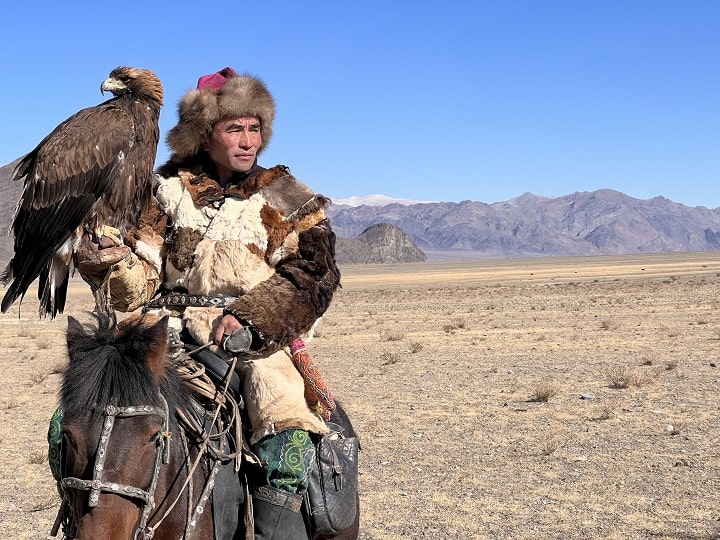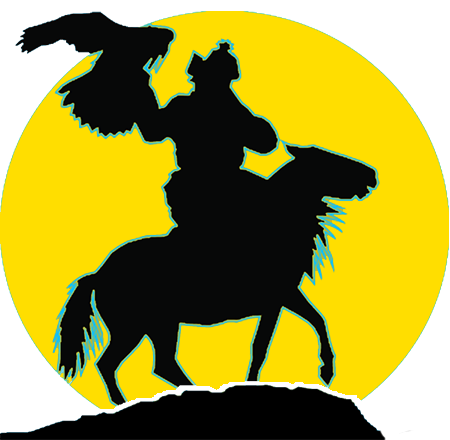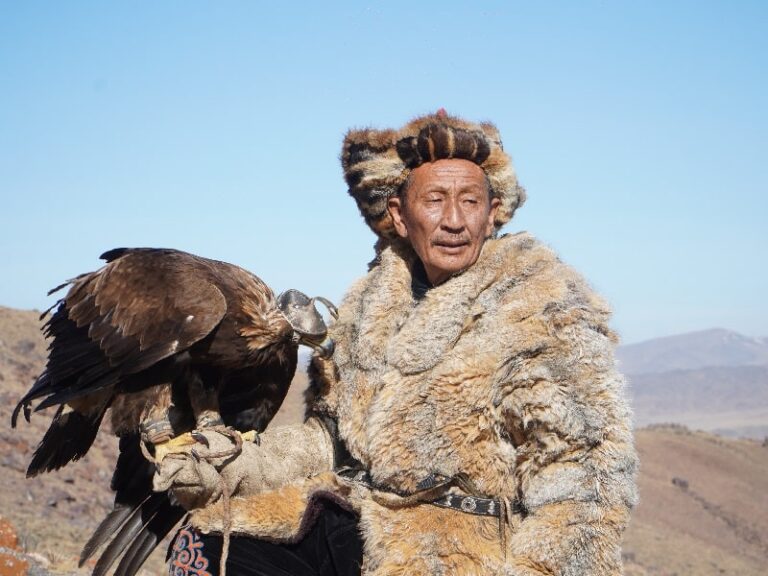Golden eagle falconry: Ancient art practiced still in Western Mongolia
A bit of history on golden eagle falconry
Golden eagle falconry is an ancient art practiced by the Kazakh Turks for over 2000 years. In the early days, Turkic people used it as a means of income by Turkic people. The warmth and value of clothes made from animal furs during this time increased people’s interest in animals, making golden eagle falconry a highly sought-after activity. While golden eagle falconry was a pastime activity done by wealthy people in a community, it was the exact opposite for the poor. They lived on by selling or exchanging furs for clothes and food. There is a legendary true story of how a golden eagle brought wealth and good fortune to a poor and ordinary man. The moral of this story is that he not only prospered in terms of earthly wealth but also honor and good fortune. This story is not a thousand years old myth but a recent instance that occurred in the early 1700s. In Kazakh history, there are plenty of such stories. Therefore, the golden eagle is considered one of the seven treasures by the Kazakh people and respected.

A bit on physical characteristics of golden eagles
These magnificent birds have abilities to fly at great heights and can spot even the smallest creatures, such as mice, on the ground. Their eyesight is 7-8 times sharper than that of humans. With speeds reaching up to 400 KM per hour, they are one of the fastest predators. Despite weighing only 6.5 kg, they can take down animals two to three times or even ten times bigger than their size by applying pressure with their sharp talons to the head of their prey. Golden eagles are said to live for around 30 years.
The golden eagle builds its nest on high cliffs and mountains, usually at heights of around 500 meters. Each year, it lays two eggs. The eaglets are fed for two months until their wings are strong enough. During this time, the mother encourages the eaglets to fly and eventually teaches them how to hunt. As they grow, they learn the skills and training from their parents, becoming fearless and skilled hunter-eagles known as “wild eagles.”
How to capture a golden eagle?
There are two well-known techniques for capturing a golden eagle for falconry purposes. The first method involves taking an eaglet from its nest, with a preference for female eaglets due to their size, strength, and hunting abilities. The second technique is trapping a wild eagle. This method is preferred because the bird has already acquired the necessary skills, requiring less time and effort to train. Experienced falconers can easily distinguish the real hunter bird from weaker ones while the bird is flying in the sky. A golden eagle is estimated to be able to catch up to 20-30 foxes a year.
Best place to witness golden eagle hunting?
Golden eagle falconry is a tradition passed down from generation to generation, from fathers to sons. Nowadays, amongst nomadic communities, only Kazakhs and Kyrgyz continue to carry on this ancient art of golden eagle falconry. If you have ever wondered how hunting was done before firearms, hunting foxes, hares, Palla cats, and sometimes even wolves with a golden eagle is a fascinating and tangible available example today. Currently, the best place where travelers can witness this thrilling art is undoubtedly Bayan-Ulgii province of Western Mongolia, and we offer a tour, hunting with a golden eagle, that allows you to experience this glorious ancient by taking you to real eagle hunters.
Interesting fact
Have you ever wondered which gender of the golden eagle to use in eagle falconry? If you asked someone to make a wild guess, that person might assume the male bird. However, surprisingly, the female golden eagle is favored for this ancient sport.
The rationale behind this choice lies in the physical and behavioral characteristics of these majestic birds of prey. Female golden eagles tend to be larger, stronger, and more skilled hunters when compared to their male counterparts, which are lazy and smaller. In the world of falconry, these attributes are valuable and vital.

